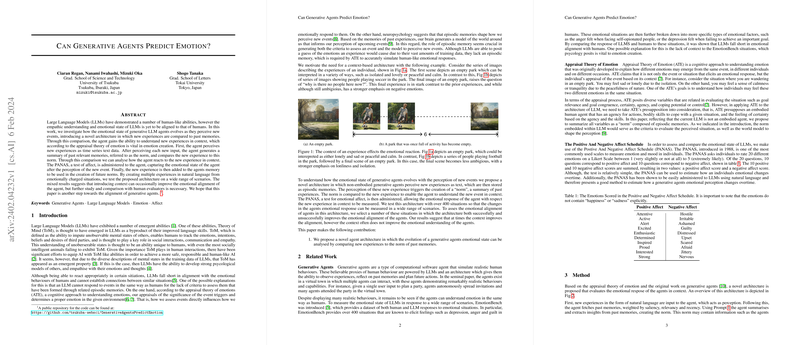Introduction
The ability of LLMs to simulate human-like functions has been well-established in various research domains. Yet, a significant gap endures when it comes to the empathic responses of these models, particularly the alignment of their emotional perceptions with those of humans. Prior studies have demonstrated emergent Theory of Mind (ToM) capabilities in LLMs but have identified limitations in emotional alignment.
Background and Context
Recognizing that human emotional responses are deeply intertwined with context, this paper focuses on introducing a new agent architecture that utilizes an episodic memory paradigm. Grounded in Appraisal Theory of Emotion (ATE) and supporting cognitive and neuropsychological theories, the paper proposes a system where an agent, upon encountering new experiences, generates a norm—a distilled summary of relevant past memories. By juxtaposing new experiences against this norm, the agent derives contextual understanding and emotional responses applicable to the situations at hand. This is crucially measured via the Positive And Negative Affect Schedule (PANAS), a well-established affective test.
Methodology
The research presents an innovative design where textual representations of experiences are stored as episodic memories. These memories, once invoked, construct a norm that is compared with new experiences. With the aim to empirically validate the architecture, over 400 scenarios were crafted, including emotionally charged events adapted into five-part stories. An agent with and without the said architecture was compared in its emotional responses to these scenarios.
Results and Evaluation
The findings of this paper were mixed yet insightful. In some instances, the inclusion of context improved the emotional alignment of agents, resonating more closely with human responses. Conversely, in scenarios where the provided context was ambiguous, the additional context did not significantly aid emotional comprehension. Crucially, the research identifies a possible positive bias in the underlying models, suggesting a tendency to favor positive emotional responses, which may skew the outcomes and interpretation of contextualized emotional responses.
Conclusion
While this paper reveals that incorporating context can refine the emotional perceptions of LLMs, it also underscores the current limitations and the influence of model bias. The paper contributes to the ongoing dialogue on the emotional intelligence of LLMs, asserting that while steps have been made towards closer alignment with human emotion, there remains considerable room for improvement. Further exploration into the impact of different models and scaling the architecture to encompass larger memory sets are posited as critical avenues for future investigation.
